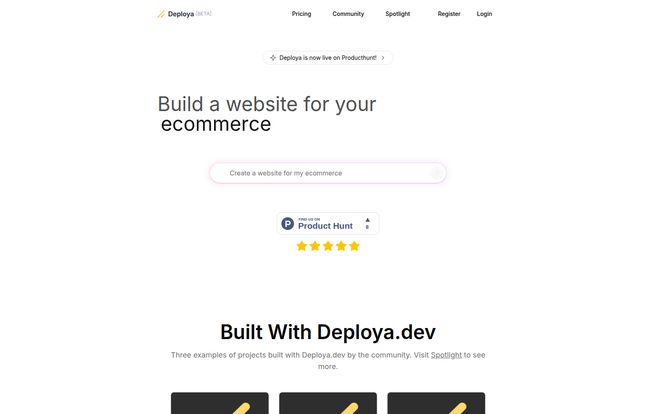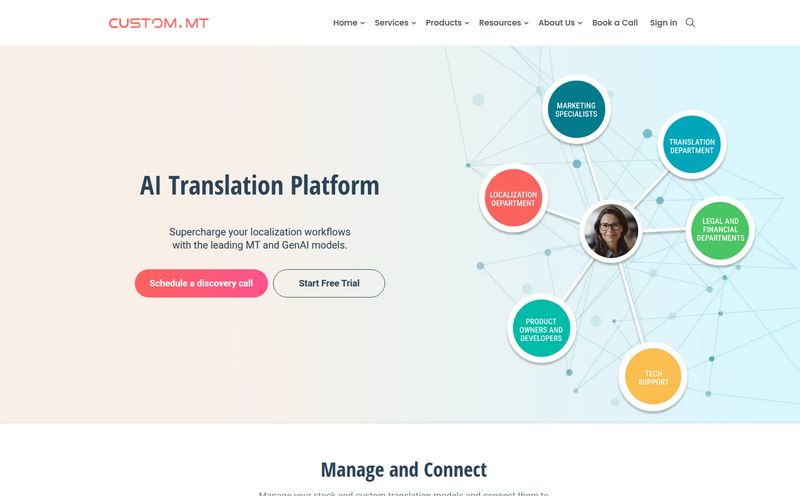I’ve been in the SEO and traffic generation game for a long time. I’ve seen platforms come and go. I remember the nightmare of hand-coding HTML tables for layouts (don't ask), the rise of clunky early CMSs, the WordPress revolution, and the drag-and-drop boom with Squarespace and Wix. Each step was supposed to make life easier.
And now, we're in the AI era. Every other tool is slapping an "AI-powered" sticker on its forehead. So when I stumbled upon a new tool called Deploya, which claims to build and deploy a production-ready website from a simple text prompt... my professional skepticism kicked in. Hard. Is this for real, or just another gimmick?
But my curiosity got the better of me. I mean, the promise of going from an idea to a live site in seconds? That’s the holy grail for so many entrepreneurs, marketers, and side-hustlers. So, I poured a coffee, cracked my knuckles, and decided to see if Deploya is the real deal or just smoke and mirrors.
So, What is Deploya Exactly?
Let's get this straight first. Deploya isn't your typical drag-and-drop website builder. It’s a no-code platform that acts more like a conversation. You tell the AI what you want—for instance, "Create a sleek, minimalist landing page for a new mobile app that tracks coffee consumption"—and it generates the website for you. Instantly. Or so they claim.
Think of it less like a set of Lego blocks and more like a magical genie. You make a wish (the prompt), and poof, a website appears. It’s designed for innovators and folks who don’t want to get bogged down in code, but it also has some interesting tools under the hood for those who like to tinker.

Visit Deploya
First Impressions: The Good, The Bad, and The Beta
Landing on the Deploya.dev site, the first thing I noticed was how clean it is. Minimalist. No fluff. I like that. It immediately gives off a modern, tech-savvy vibe. Right at the top, you see the word [BETA]. This is important. It's an honest admission that this is a work in progress. As a user, I appreciate that transparency. It means, “Hey, we’re new, we’re cool, but there might be a few rough edges.”
The core proposition is bold: "Build a website for your ecommerce." That's a huge task. Ecommerce sites are complex beasts with product pages, carts, checkouts... Can a simple prompt really handle all that? That’s the multi-million dollar question, isn't it?
Key Features That Actually Matter
Beyond the main AI prompt, a few things stood out to me as genuinely interesting from an SEO and dev perspective.
The Magic Prompt: From Text to a Live Site
This is the star of the show. The ability to generate a site's foundation just by describing it is, frankly, pretty wild. For a marketer like me who needs landing pages for new campaigns yesterday, the potential here is enormous. It's not about creating a final, perfect masterpiece in one shot. It's about getting 80% of the way there in 1% of the time. The time saved on initial wireframing and structure building alone is a massive win.
More Than Just a Pretty Face
Here’s what surprised me. Deploya isn't just for total beginners. They mention features like a Cloud IDE and Development Environments. This suggests that once the AI has done its thing, a developer (or a curious amateur) can pop the hood and fine-tune the code directly in the cloud. This hybrid approach is smart. It bridges the gap between the no-code world and traditional development, offering a path to greater customization that most basic builders lack.
Instant Deployment Gratification
In my world, speed is everything—both for user experience and for Google's crawlers. The idea of "instant deployment" is music to my ears. The friction of configuring servers, dealing with FTP clients (ugh), and managing hosting environments is one of the biggest headaches in web creation. If Deploya truly makes going live a one-click affair, they've solved a major pain point.
Let's Talk Money: The Deploya Pricing Plans
Okay, let's get down to brass tacks. Is this thing going to cost an arm and a leg? The pricing structure is actually pretty clear, which is a breath of fresh air. It's broken down into three tiers.
First up, you have the Free plan. For $0 a month, you get 10 prompts. This is your test drive. It’s enough to get a feel for the platform and see if the AI's creations match your vision. The catches? Your projects aren't private, and they only keep your data for 7 days. It's a classic free sample—enough to get you hooked, but not enough to run a business on. It's perfect for what it is: testing.
Next is the Pro plan at $19.90 per month. This is where things get serious. You get a much healthier 100 prompts, can create 100 private projects, and have unlimited data retention. This is clearly aimed at regular users—freelancers, small businesses, and serial entrepreneurs who are constantly spinning up new ideas. In my opinion, for under 20 bucks, the value proposition is pretty strong if the tool delivers on its promises.
Finally, there’s the Enterprise plan. This is the classic "Contact us" model for large teams and companies. You get custom everything, plus the big-ticket items like SSO (Single Sign-On), API access, and custom integrations. This is for the big players who want to integrate Deploya deep into their workflows.
A Reality Check: Who Should Actually Use This?
So, is Deploya for everyone? Nope. No tool is.
This is perfect for entrepreneurs with an idea who need an MVP or a landing page to validate their concept without hiring a developer. It's for the marketer who needs a campaign-specific page built and launched before their morning coffee gets cold. It could also be a killer tool for small agencies looking to rapidly prototype designs for clients.
However, if you're building the next Amazon with incredibly complex, bespoke backend logic and a unique server architecture, this probably isn't your starting point. It's a tool for speed and convenience. The trade-off, as with any no-code platform, is a degree of control. But for a huge number of use cases, it's a trade-off worth making.
And let's be real, it's still in Beta. I've been in this industry long enough to know what that means. You're going to hit a weird bug or two. You might find a feature that doesn't work exactly as expected. You're an early adopter, and that comes with both the excitement of being first and teh occasional frustration of a product that's still finding its feet.
So, Is Deploya Worth The Hype?
I came in skeptical, but I’m leaving intrigued. Very intrigued.
Deploya feels like a genuine step forward. It's not just another template repository. The core concept of conversational, AI-driven development is powerful. While it's still early days (remember that BETA tag!), the potential is undeniable. The ability to eliminate the initial heavy lifting of web design and development could fundamentally change how quickly we can bring ideas to life online.
Should you try it? Absolutely. The free plan costs you nothing but a few minutes of your time. Go see for yourself if the AI genie can grant your web design wishes. I, for one, will be keeping a very close eye on Deploya.dev. They might just be onto something big.
Frequently Asked Questions
- 1. How does Deploya's AI actually build the website?
- You provide a natural language text prompt describing the website you want. The AI interprets your request—looking at keywords related to style (e.g., 'minimalist', 'bold'), structure (e.g., 'landing page', 'portfolio'), and content (e.g., 'for a coffee app')—and then generates the corresponding HTML, CSS, and JavaScript code to create a functional website layout.
- 2. Can I customize the website after the AI generates it?
- Yes. While the initial creation is AI-driven, Deploya provides a Cloud IDE and development tools. This means you or a developer can go into the generated code to make specific tweaks, add custom features, or change the design, offering more flexibility than many standard builders.
- 3. How good are Deploya-built websites for SEO?
- This is the million-dollar question for me! Since the AI generates standard code, the foundation should be SEO-friendly. The key will be ensuring the generated sites use proper heading structures (H1, H2s), are mobile-responsive, and load quickly. As with any tool, the final SEO performance will also depend heavily on the quality of your content, your keyword strategy, and your backlink profile.
- 4. How quickly can my website really go live?
- The generation and deployment process is designed to be extremely fast. From entering your prompt to having a live, shareable URL can take just a matter of seconds or minutes. This is one of its main selling points, especially for time-sensitive projects like marketing campaigns.
- 5. What happens when I use all 10 prompts on the free plan?
- Once you've used your 10 prompts on the free tier, you'll need to upgrade to the Pro plan to continue generating new websites. The free plan is designed as a trial to let you experience the core functionality before committing.
- 6. Is Deploya just for ecommerce sites?
- No, despite the example on the homepage, the technology can be used to create all sorts of websites, including portfolios, blogs, landing pages, and business brochure sites. The 'ecommerce' example is likely used to showcase its ability to handle more complex layouts.
Conclusion
The rise of AI in the creative and development space is something none of us can ignore. Tools like Deploya are not just novelties; they represent a fundamental shift. They are lowering the barrier to entry, making it possible for anyone with a good idea to create a presence on the web. It's not about replacing developers, but about empowering creators. And that’s a future I'm genuinely excited to be a part of.



